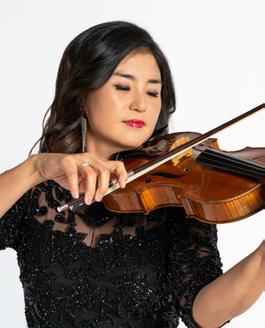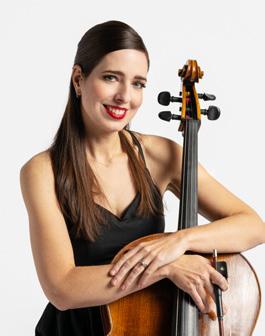ONE HUNDRED THIRTY-FOURTH SEASON
Sunday, April 27, 2025, at 3:00
South Shore Cultural Center
CSO Chamber Music Series
SOUTH LOOP QUINTET
So Young Bae Violin
Danny Yehun Jin Violin
Wei-Ting Kuo Viola
Sunghee Choi Viola
Karen Basrak Cello
MOZART
String Quintet in C Major, K. 515
Allegro
Menuetto: Allegretto
Andante
Allegro
SO YOUNG BAE
DANNY YEHUN JIN
WEI-TING KUO
SUNGHEE CHOI
KAREN BASRAK
INTERMISSION
DVOŘÁK
String Quintet in E-flat Major, Op. 97 (American)
Allegro non tanto
Allegro vivo—Un poco meno mosso
Larghetto
Finale: Allegro giusto
DANNY YEHUN JIN
SO YOUNG BAE
SUNGHEE CHOI
WEI-TING KUO
KAREN BASRAK
The Chicago Symphony Orchestra Association acknowledges support from the Illinois Arts Council.
COMMENTS by Richard E. Rodda
WOLFGANG MOZART
Born January 27, 1756; Salzburg, Austria
Died December 5, 1791; Vienna, Austria
String Quintet in C Major, K. 515

COMPOSED 1788
The year 1786 was the zenith of Mozart’s career in Vienna. Perhaps because of intrigue but more probably because the geometrical expansion of expression in his newest music did not suit the fickle taste of the Viennese, his local popularity began to wane. Though he tried to economize by moving from his spacious apartment in the Schullerstrasse (now a Mozart museum known as the Figaro House) to a smaller flat at 224 Landstrasse, he could not abandon his taste for fine clothes and elegant entertaining and took on debts, several of which were to the textile merchant Michael von Puchberg, a fellow Mason. On April 2, 1788, an announcement signed by Mozart appeared in the Wiener Zeitung stating that he was offering for sale by subscription three new quintets “finely and correctly written” that would be available at Puchberg’s establishment in the Hohe Markt after July 1. The intention was that Puchberg would keep
the proceeds to repay a debt. To create the promised trio of works (eighteenthcentury publishing practice demanded that instrumental works usually be issued in sets of three, six, or twelve), Mozart created anew the quintets in C major (K. 515) and G minor (K. 516) and arranged the magnificent wind octet in C minor (K. 388) for five strings (given the curious Köchel number 406). The quintets were completed in April and May 1787 during a hectic interruption in the composition of Don Giovanni (those same weeks saw Mozart’s only meeting with Beethoven, when the sixteen-yearold Bonn musician came to Vienna for a fortnight of lessons, and the death of Papa Leopold Mozart in Salzburg), but the number of subscribers was so small that Mozart placed another ad in the Viennese press on June 25. This, too, was largely ignored, and the project was dropped, though Artaria brought out K. 515 in 1789 and K. 516 a year later. Mozart returned to the string quintet form in December 1790 and April 1791 with works in D major (K. 593) and E-flat (K. 614) for the wealthy Hungarian amateur violinist Johann Tost. They were the last pieces of chamber music he wrote.
this page: Wolfgang Mozart, portrait sketched and engraved by Edmé Quenedey (1756–1830). Musée Carnavalet, Paris, France | opposite page: Antonín Dvořák, portrait by Jan Vilímek (1860–1938), ca. 1890–91. National Library of the Czech Republic
Commentators have consistently noted the enormous scale and virtually symphonic scope of the C major quintet. “With the remarkable total of 1,149 bars, it is by far the longest of all Mozart’s compositions in four movements,” calculated A. Hyatt King. In his landmark book The Classical Style, pianist and scholar Charles Rosen noted that “the first movement is the largest ‘sonata-allegro’ before Beethoven, longer than any other Mozart ever wrote or any that Haydn had written or was to write. . . . [though] size by itself means little,” Rosen continued. “Pacing and proportion are everything.” Pacing and proportion, of course, are the very essence of classical music, and by the late years of his life, Mozart had achieved a mastery of them at which even Haydn marveled. The grace, grandeur, and optimism of the C major quintet are evident from its first measures, which introduce as
ANTONÍN DVOŘÁK
main theme an upward traversal of the tonic chord by the cello that is greeted with a closing reply by the violin. This apparently simple thematic pattern is the subject of some bewitching, protoromantic harmonic peregrinations before a contrasting thought, a flowing line of undulating shape, is advanced by the violin. Both motifs are treated expansively in the development section before their full recapitulation rounds out the movement. The second movement, with its irregular phrase lengths, uncertain tonality, and chromatic inflections, brings an element of pensiveness to the score that was only hinted in the opening Allegro. The Andante is an elaborate, almost operatic duet for the first violin and the first viola in the form of a sonatina (sonata without a development section). The finale, a skillful combination of sonata and rondo, resumes the buoyancy and high spirits of the first movement.
Born September 8, 1841; Nelahozeves, Bohemia
Died May 1, 1904; Prague, Bohemia
String Quintet in E-flat Major, Op. 97 (American)

COMPOSED 1893
On June 3, 1893, Antonín Dvořák left his apartment at 327 East 17th Street in New York City and journeyed via Philadelphia, Pittsburgh, and Chicago to Calmar, Iowa. An hour after arriving at Calmar, a carriage deposited him, his wife, their six children, a maid, and the composer’s secretary at the doorstep of a sturdy two-story brick house in Spillville, a settlement of a few hundred souls founded some forty years before by a German named Spielmann. It was not
the Germans, however, who followed Spielmann to the open spaces of Iowa, but the Bohemians, Dvořák’s countrymen, among whom were members of his secretary’s family, the clan Kovařík. Though Dvořák was certainly not uncomfortable in his position as director of the National Conservatory in New York (he boasted in a letter to one friend about his $15,000 salary, an enormous sum in the 1890s), he missed Prague, hearing Czech spoken in the streets, his pigeons, and the traditional songs, so he was easily persuaded by Papa Kovařík, Spillville’s school teacher and choirmaster, to spend the summer of 1893 in the little slice of his homeland that had dropped onto the Midwestern prairie. In his Reminiscences, Kovařík recorded the following information: “The Master’s day in Spillville was more or less as follows: He got up about four o’clock and went for a walk—to the stream or river—and returned at five. After his walk, he worked; at seven, he was sitting at the organ in church, then he chatted a little, went home, worked again, and then went for another walk. . . . Almost every afternoon he spent in the company of some of the old settlers. He got them to tell him about their bitter

and difficult beginnings in America. . . . He liked being there.” Though there was little musical stimulation for him in Spillville (considerable energy had to be expended just to find a piano for his rooms), Dvořák’s creativity blossomed there. Just three weeks after he arrived, he completed the F major quartet (op. 96, known since it was new as the American) and immediately began a quintet for two violins, two violas, and cello that was completed on August 1, just before he left for a week to participate in a Czech Day at the Chicago World’s Fair. In mid-September, before returning to New York, Dvořák wrote to Dr. Emil Kozánek in Kromĕříž, “The three months spent here in Spillville will remain a happy memory for the rest of our lives. We enjoyed being here and were very happy, though we found the three months of heat rather trying. It was made up to us, however, by being among our own people, our Czech countrymen, and that gave us great joy.” Both the quintet and the quartet were officially unveiled by the Kneisel Quartet in Boston on New Year’s Day, 1894; the performance was repeated twelve days later at Carnegie Hall in New York.
above: The Dvořák family, New York City, 1893
Certainly, the most exotic diversion for Dvořák during his Iowa retreat was the visit of a traveling band of Kickapoo Native Americans headed by Chief Big Moon and his wife, Large Head, members of the Algonquin tribe, who stopped in Spillville to sell some of their medicinal herbs. They performed in the open for several nights, and Dvořák was so taken with their songs and dances that he invited them into the village tavern and convinced them to continue the show. As he had when his student Henry Thacker Burleigh sang the old spirituals and plantation songs for him in New York, Dvořák noted down some of the music’s melodic phrases and characteristic rhythms and added them to his collection of indigenous American sources. It is not surprising that the quintet he was writing at just that time is tinged with the evocations of those Algonquin musicians, though their music was finely filtered and much transmuted through his Czech sensibility. In an interview that appeared in the Chicago Tribune on August 13, 1893, Dvořák said, “In this work, I think there will be found the American color with which I have endeavored to infuse it.”
The opening movement of the E-flat major string quintet grows from a pentatonic theme previewed in a shimmering setting that serves as an introduction. The music becomes more animated for the formal presentation of the main theme. The
dotted-rhythm complementary subject, introduced by the second violin above the cello’s pizzicato, bears a folkish quality that recalls passages from the New World Symphony, composed just a year before this quintet. The development section includes permutations of both themes and leads to their heightened restatements in the recapitulation. The following Allegro, which serves as the quintet’s scherzo, is as close as Dvořák came to donning a Kickapoo headdress. It begins with a mock drumbeat from the viola and continues with another pentatonic melody of simple construction. The central section is given over to a long, minor-mode melody initiated by the viola. The third movement is a set of five variations on a two-part theme (minor, then major) that Dvořák sketched in December 1892, the first bit of music he wrote after arriving in America. (He is said to have considered for a time composing a new national anthem utilizing the second half of this melody for the text “My country, ’tis of thee.”) The finale is an invigorating blend of rondo and sonata elements, much of which is based on the skipping rhythms of the opening measures.
Richard E. Rodda, a former faculty member at Case Western Reserve University and the Cleveland Institute of Music, provides program notes for many American orchestras, concert series, and festivals.





